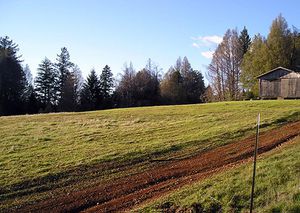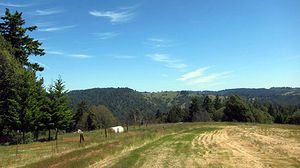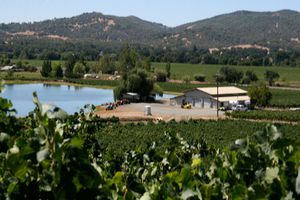Evaluating Undeveloped Land for Vineyard Potential

By RICHARD NAGAOKA and CHARLES KAMINS
In a previous article we discussed the methods used to evaluate an existing vineyard for purchase or redevelopment. With existing vineyard prices reaching astronomical levels, grape growers, wine makers and investors are looking at alternatives. This week we'll walk through the process of evaluating an undeveloped piece of dirt for vineyard development.
Evaluating undeveloped land is far more complex than buying an established vineyard. There are a plethora of questions to be addressed before a prudent decision can be made. With undeveloped land, the buyer has no past crop performance history for reference. If there are no neighboring vineyards on similar soils, the grower needs to be able to evaluate soil and climate then factor in the characteristics of the grape variety and rootstock and cultural practices to arrive at a picture of the future vineyard before the first vine is planted. It is like shopping for a home in that respect; don't we have to emotionally move in as part of the process? For each site, we have to invent a vineyard.
Start with the dirt

Among the many questions that need to be answered:
- Is the soil acceptable for grape vines? Although it has been said that a vine can grow on a rock, too little soil will not supply a vine with sufficient nutrients and moisture. Even 3 to 4 inches of soil will produce green grass in the Spring following the winter rains and vines will grow on very shallow soils. But vines planted on shallow soils have little reservoir of moisture except as provided by drip irrigation. You can imagine what would happen to such a vineyard during the summer if the irrigation pump breaks down for two weeks.
- Conversely, too much water, such as with a saturated sub-soil, can drown the roots and encourage root-rot. When I see unplanted level ground in the Napa Valley lately it makes me wonder what's wrong with it. If the subject parcel is located in a large unplanted area north of Calistoga, it is imperative to check the soil and water chemistry for excess [1]. If it's hillside land, planting is restricted to slopes of less than 30% as prescribed by the Napa County Hillside Ordinance. On any site with greater than 5% slope, a vineyard developer will have to apply erosion control measures in order to get a permit to grade or clear the hillsides.
It's important to evaluate the soil chemistry of the parcel and this will require samples from all over the property if it's large. Even though it's rarely a problem in this area, I recommend a test for toxins like Boron and, a problem that's sometimes overlooked, can be an adverse ratio of magnesium to calcium. In a few locations near Whitehall Lane and parts of Pope Valley too much magnesium (For example 3-5 parts to each part Calcium) can ruin the vines' whole day. Leaves curl and drop off and the fruit matures poorly. There are ways to mitigate these effects but most buyers stay away from such Serpentine derived soils. Some success mitigating the problem has been achieved by fertigating (fertilizing through drip irrigation) with liquid potassium diluted in each irrigation. At any rate, a chemical imbalance in the soil adds extra costs to vineyard development.
Water Issues

Another important question to ask regarding undeveloped land is whether there is a source of irrigation water for the vineyard? Water needs can be satisfied with a well, surface run-off, municipal water or irrigation district water or a combination of the above with storage tanks or a reservoir. How much water is required? The amount of water for irrigation varies between 0.25 - 1.5 acre feet per acre per year (1 acre foot = 325,000 gallons) as dictated by the soil depth. Keep in mind we often supply less water to reds than whites but that is a minor amount in the overall view. For example deep fertile soils near the Napa River can be unirrigated or 'dry farmed.' Vineyards on very cobbly mountain soils with low water holding capacity and with dense spacing of the vines will almost inevitably be dependent on irrigation water. We can calculate an estimated budget of how much irrigation water will be needed by subtracting available soil moisture from the vines' total consumption. Most vineyards budget about 100 gallons of water per vine per year.
For frost protection with overhead sprinklers, 50 gallons per minute per acre is required. An important consideration in evaluating undeveloped land for vineyard development is whether the property is subject to spring-time frosts? The exposure of green grape vine tissue to temperatures lower than 31 degrees Farenheight for 30 minutes could cause crop loss. Hillside vineyards between 50 and 400 feet in elevation, on the other hand, are usually frost free because cold air drains off hillsides and because of the inversion layer, that is, a warm layer of air that forms on most evenings in the Napa Valley. Vineyards above 800 feet on Howell Mountain, however are above the inversion and can be colder than valley floor vineyards. Wind machines are of little use under these conditions and overhead sprinkler irrigation is dictated. On the Napa Valley floor, wind machines or orchard heaters can protect vineyards to as low as 29 degrees F. In Pope and Knights Valleys, temperatures can be much colder and for longer durations. In some years and locations as much as 50 hours of frost protection per year are common.
Matching the variety to the soil and climate
In evaluating raw land is is important to establish which varieties are appropriate for the local climate as well as the soil-depth and texture. Climate and soil dictate the variety's personality. Different styles of wine are produced from different parts of Napa Valley. Chardonnay from Carneros is fruity, while Chardonnay from Up Valley tends to be 'buttery' and 'fat.' For red wines, cobbly, hillside soils might produce concentrated, intense Cabernet, while valley floor Cabs might be flabby and vegetal. It's important to keep in mind that soil differences can occur from one side of the road to the other. As an example, in some cases, grapes of the same variety will get different prices depending on whether the vineyard is on the east or west side of Highway 29 at Oakville or at Skellenger Lane near Rutherford.
A consideration in evaluating raw land includes whether or not the vineyard will have to comply with the Napa County Hillside Ordinance. If the slopes are greater than 5% an erosion control plan must be submitted and approved before you can disturb the soil. Generally, these plans are prepared by engineers as they require precise calculations based on estimated rainfall over a wide area, sizing and placement of culverts and erosion mitigating techniques.
The questions discussed here are the same ones that need to be addressed for the first time or seasoned buyer. As the wine industry expands and costs soar into the stratosphere, it's essential to take advantage of the services of industry professionals such as Realtors, lenders, engineers and viticulturalists to help make your project a success.
References
- ↑ boron
